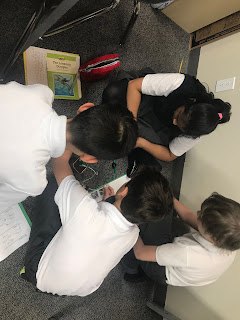We began the day practicing our multiplication skills. Each day we are given ten minutes to fill in a multiplication chart. It is very important that students know their multiplication table and are able to use this knowledge to improve on their division skills. We reviewed our homework about using mental math strategies and then we moved onto Divisibility Rules. We practiced some examples as a class.
Success Criteria:
I can recognize that a number is divisible by:
-2 if the number is even
-3 if the sum of its digits is divisible by 3
-4 if the number represented by the last 2 digits is divisible by 4
-5 if the last digit is 0 or 5
-6 if the number is divisible by 2 and 3
-8 if the number represented by the last 3 digits is divisible by 8
-9 if the sum of the digits is divisible by 9
-10 if the last digit is 0
We then took up our homework on the forms of energy and then we watched an introduction to electricity video and practiced note-taking.
We made notes while watching this video also.
We came to understand that electrons leave through the negative end of the battery and move from atom to atom through the electric circuit in order to reach the positive end.
Ms. Jaskolka has a silly joke to help us remember this: the electrons do not want to hang out with those who think negatively but instead they want to go hang out with their positive thinking friends!
Here is a video for students to learn more about atoms:
It is important that we have a basic understanding of atoms so that we can have a better understanding of the flow of electricity.
Important points:
-everything is made up of atoms!!
-The tiny particles called atoms are the basic building blocks of all matter.
-Atoms can be combined with other atoms to form molecules, but they cannot be divided into smaller parts by ordinary means. The word atom comes from the Greek word atomos, meaning “indivisible.” The basic particles that make up an atom are electrons, protons, and neutrons.



Success Criteria:
I can:
-accurately and with understanding take notes about current and static electricity
-identify that electricity is the movement of charged particles called electrons
- identify that a battery creates the force to move electrons
-identify conductors create the path for electrons to move
-identify electrons are a negative charge that are attracted to the plus end of a battery, moving from minus to plus
-flowing electrons are called current (amps)
-identify that the force of moving electrons is measured in volts
-identify how a short circuit can occur
After first recess and lunch we had French.
Next!!!!! We explored electricity circuits using trouble shooting strategies to turn on light bulbs. Students were given wires, 6V batteries, light bulbs and holders, switches and the ‘Light Up the Class’ worksheet.
We ensured to discuss safety precautions.
SAFETY CAUTION! when a wire is connected directly from on terminal of the battery/cell to the other terminal of the battery. As there is not bulb (resistor) between the terminals, electric current can flow unimpeded. The wire will get hot and could melt the insulation.
The worksheet challenged students to use the electric components to build various circuits in groups. Students drew pictures of each circuit that successfully met each challenge. Students then used this knowledge to identify correctly constructed electric circuits. Students also read about and added Thomas Edison to their Electric Timeline.
Success Criteria: I can
- Make a light bulb go on
- Make a light bulb go on and off using the switch
- Make two light bulks go on at the same time
- Make one light bulb stay on when the other is unplugged
- Work safely with electric circuits as I understand how to avoid a short circuit
- Use troubleshooting skills to correct problems in electric circuits
After second recess and lunch we had physical education.
Homework:
1. Read about electricity (sheets given to students)
2. Math sheets on divisibility rules
3. Simile sheet
4. Research and add Thomas Edison to timeline
5. Science Fair letter and and money
6. Finish 'light up the class' if not completed in class (communication questions 1-4)
7. Terry Fox letter and pledges
8. Return last page of handbook'
9. Friday gym clothing and house colours shirt































No comments:
Post a Comment